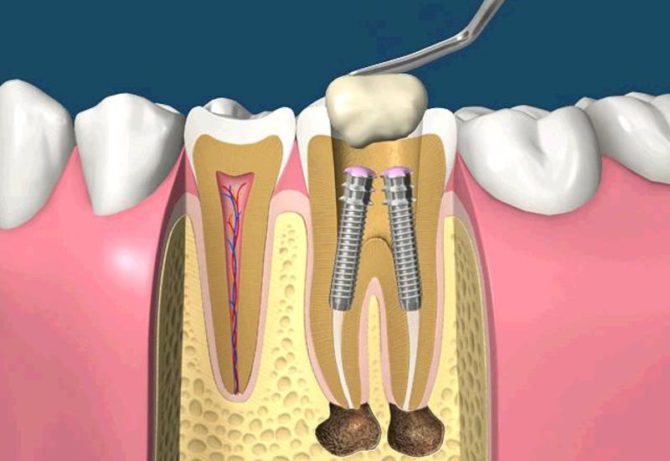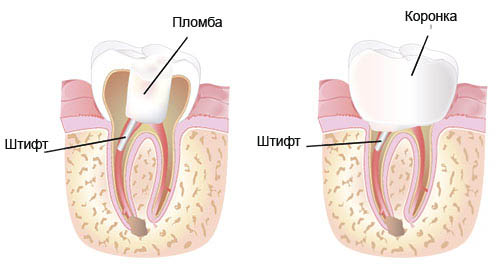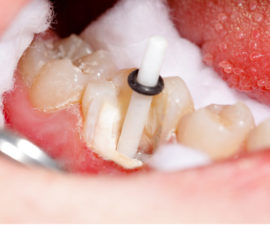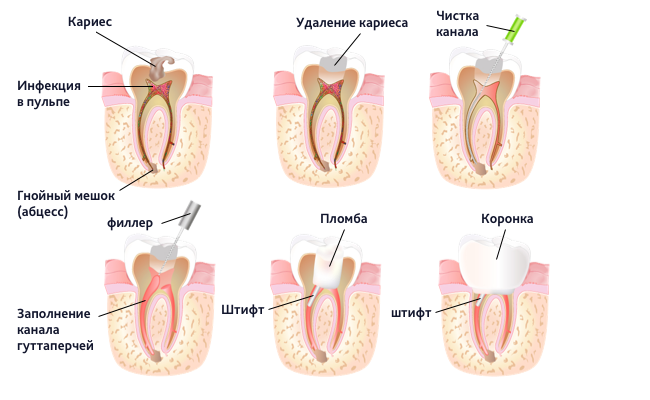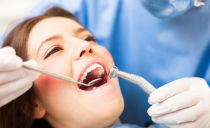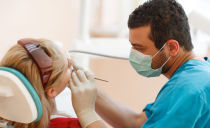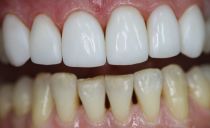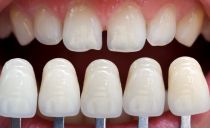A pin in a tooth: what is it, how are they put, types, cost
To restore and correct teeth, dozens of methods have been developed today, each of which is designed to quickly and painlessly solve a specific clinical problem. With carious damage, the tabs have proven themselves best, and in the absence of support for the tooth pins come to the rescue. The installation of the pin during dental prosthetics is carried out as follows: one end of the shaft is screwed into the root canal, and a beautiful new tooth is attached to the other.
Content
What is a tooth pin
Dentists call a pin a special threaded rod. With its help, one end of the pin is screwed into the root of the tooth, a prosthesis is installed on the second end of the structure. The pin method of tooth extension is relevant in cases where the upper part of the tooth is badly damaged and the root canals are in normal condition.
Benefits
- Aesthetics. The technology allows you to restore the beautiful appearance of heavily damaged and damaged teeth, including the front.
- Preservation of the tooth root, which does not occur during implantation.
- Functionality. Artificial pin teeth fully cope with the functions of natural, without causing any inconvenience and without requiring special care.
- Long service life. The tooth extended on a pin serves more than 10 years.
The risks of pin prosthetics
- In the case when the pin is installed in a weakened root, thinning of the tooth walls is possible with subsequent destruction.
- Incorrect installation can lead to the spread of the carious process.
- Metal pins, although to a small extent, are still susceptible to corrosion.
- When removing the pin, it may be necessary to remove it with the root.
- Individual intolerance to the materials of which the pin is made is possible.
Why do I need a pin in the tooth
The decision on the appropriateness of the pin extension is made by the doctor. Indications for using the pin method are:
- Dental crown destruction by more than 50 percent.
- Strong weakening of tooth enamel as a result of dental diseases or their treatment.
- The need for a solid support for prosthetics.
- Extraction of a tooth during the treatment of infection with subsequent return to the hole.
Contraindications
In some cases, the pin design is contraindicated. The possibility of installing pins during dental prosthetics is determined by the doctor after studying the anamnesis, conducting a study of a damaged tooth and assessing the condition of the oral cavity.
In most cases, an obstacle to put a pin immediately become inflammatory processes in the oral cavity. In this case, the pin structures are installed after treatment.
Direct contraindications to the installation of pins are:
- lack of a tooth crown in the front;
- narrowness of root canals: width less than two millimeters;
- the inability to give a cylindrical shape to the root canal;
- insufficient root height;
- the presence of cysts and granulomas in the oral cavity;
- bleeding disorder, including during menstruation in women;
- pregnancy;
- mental disorders;
- any dental diseases of an inflammatory nature in the acute stage;
- complete destruction of the tooth crown.
Types of pins in dentistry
Dental pins vary in manufacturing material, resilience, fixation method and shape. The doctor chooses the appropriate design after a thorough examination, conducting the necessary studies and interviewing the patient. To make sure that there are no contraindications to the installation of the rod, the width and depth of the channels are sufficient, the doctor should conduct an x-ray examination.
By material
- Anchor pin is the most popular in dentistry. This is due to the fact that with its help teeth are restored with a maximum degree of crown destruction. Extremely important
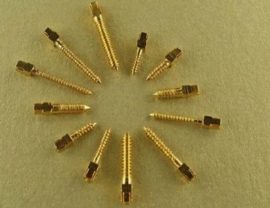 condition of the root of the tooth: the pin can be installed only if it is intact and healthy. The product is made of an alloy of various metals: stainless steel, brass, palladium, titanium and even gold. Due to its high strength, lightness and low cost, titanium pins are most often used in dentistry. The main advantage of the anchor pin is the reliable retention of the restored part of the tooth and the possibility of further installation of prostheses. The disadvantages include susceptibility to corrosion, difficulty in removal and visibility. Anchor pins can be installed both in a passive and an active way.
condition of the root of the tooth: the pin can be installed only if it is intact and healthy. The product is made of an alloy of various metals: stainless steel, brass, palladium, titanium and even gold. Due to its high strength, lightness and low cost, titanium pins are most often used in dentistry. The main advantage of the anchor pin is the reliable retention of the restored part of the tooth and the possibility of further installation of prostheses. The disadvantages include susceptibility to corrosion, difficulty in removal and visibility. Anchor pins can be installed both in a passive and an active way. - The fiberglass pin is the second most popular. Its difference is high elasticity, hypoallergenicity and easy extraction. The construction is made by
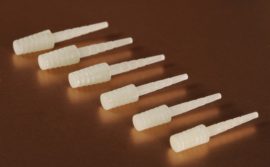 immersion of fiberglass in a plastic form in such a way as to create an equivalent load on the hard tissues of the tooth. Visually, the fiberglass pin is almost invisible (see photo), since its color coincides with the enamel pigment. The disadvantage of the product is a 15 percent probability of destruction of dental tissue.
immersion of fiberglass in a plastic form in such a way as to create an equivalent load on the hard tissues of the tooth. Visually, the fiberglass pin is almost invisible (see photo), since its color coincides with the enamel pigment. The disadvantage of the product is a 15 percent probability of destruction of dental tissue. 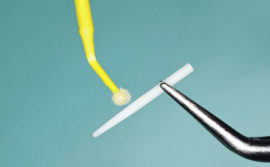 Carbon fiber dental pins are very flexible, which reduces the load on the root of the tooth, prevents fracture of the canals. The structure of the material is close to the dentin layer of a natural tooth, due to which the product is strong and durable.
Carbon fiber dental pins are very flexible, which reduces the load on the root of the tooth, prevents fracture of the canals. The structure of the material is close to the dentin layer of a natural tooth, due to which the product is strong and durable.- Parapulpar rods are made of metal
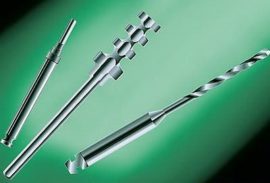 alloy, and outside are covered with polymer. They are mainly used for reinforcing filling material with a tooth cavity. They are inserted into hard tissues without penetration into the pulp. On the one hand, this eliminates the possibility of penetration into bacteria and the development of inflammation, on the other hand, limits the range of applications.
alloy, and outside are covered with polymer. They are mainly used for reinforcing filling material with a tooth cavity. They are inserted into hard tissues without penetration into the pulp. On the one hand, this eliminates the possibility of penetration into bacteria and the development of inflammation, on the other hand, limits the range of applications.
By elasticity
- Elastic pins better protect the tooth from fractures and impacts.
- Inelastic is preferred to support restorative structures, prostheses and bridges.
Pin shaft shape
When choosing the shape of the rod, the doctor proceeds from the individual shape of the root canal. The following rod shapes have been developed:
- conical;
- cylindrical;
- cylindrical conical;
- screw.
Installation methods
- Active. The shaft is screwed into the root of the tooth with the help of a thread and is used as a support under a full crown.
- Passive. The rod is inserted and fixed in the root canal with the help of special cement, it does not need to be screwed. The structural strength is lower, but this method is more sparing for tooth tissues.
Installation of pins for dental prosthetics
Preparing to install pin structures should not be on the day of surgery, but at a preliminary consultation. After the dentist has determined the feasibility and the possibility of pin prosthetics, he must analyze in detail the condition of the tooth and study the thickness of its tissues. Given all the factors, the doctor chooses the best materials and mounting options.
In that case, if inflammatory processes and any other pathologies that may complicate the operation have been identified, their treatment is carried out. After that, an additional inspection is required.When the doctor is convinced that there are no contraindications, immediate preparation for prosthetics will begin.
The day before installing the pin, it is recommended to undergo a procedure for brushing your teeth from stones and plaque. This will help minimize the number of bacteria that can get on the wound surface after manipulation. You must not eat six hours before installing the pin.
Procedure
First of all, an anesthetic injection is injected into the gums to anesthetize the place of work. After the anesthesia has acted and the doctor has checked the surface for susceptibility, installation work begins. The dentist prepares the root canal, removes the nerves, clears and, if necessary, expands the canal. The working area is treated with an antiseptic solution.
If a passive pin is used, the channel is pre-filled with cementitious mixture, and the rod is immersed in it. The active pin is screwed into the channel, and the voids are filled with a polymer composition. For better fixation, the solution is dried with a halogen lamp.
When the shaft is screwed in and securely fixed, a prefabricated artificial tooth prosthesis is placed on it. For fixing, temporary cement is used, this is done in order to check the material for rejection. If the surrounding oral tissue normally responds to a foreign element, after a week the prosthesis is placed on a permanent basis. If necessary, the doctor adjusts it using grinding. After installing the pin, the patient should not have the slightest discomfort, the further outcome of treatment depends on strict adherence to the recommendations of the dentist.
Rehabilitation
The first time after installing the pin, you must strictly adhere to a number of restrictions and recommendations. How long the rehabilitation period will last can only be said by the doctor who conducted the treatment. For the entire period of rehabilitation should:
- Eliminate solid and viscous foods that require active chewing movements from the diet. The food should be soft or even grated.
- In the first day you should not brush your teeth, only rinsing is permissible. In the future, you will need to give preference to brushes with soft or medium bristles.
- To exclude products and objects that can violate the integrity of the teeth: nuts, seeds, toothpicks.
- Do not miss visits to the dentist and strictly follow individual recommendations.
How much does a pin installation cost
The price for installing an artificial tooth on a pin depends on the region and the type of product selected. In Moscow clinics, dentists are traditionally more expensive to prosthetics. The cheapest will cost a titanium anchor per tooth, a fiberglass pin will cost 2.5 times more.
It is important to proceed from the advisability of installing one or another type of pin. You need to consider what will be better for the teeth, in which part of the jaw the manipulations are performed, whether subsequent prosthetics are planned, what is the budget for the treatment. An experienced dentist will help you choose the best option.
Does it hurt to put a pin in the tooth
Putting a pin in the tooth is not painful, since with such prosthetics local anesthesia is used. When the procedure is completed, and the effect of anesthesia passes, some discomfort is possible, but there will be no pain even after the procedure.
Before making a final decision in favor of prosthetics using a pin, you need to consult a dentistry department. The doctor must explain how the procedure will go, why to insert this or that material, what are the consequences and are there any guarantees for the installed structure. The pin is placed for a long time, so it is important to choose an experienced specialist who will correctly select the material and professionally perform prosthetics.

